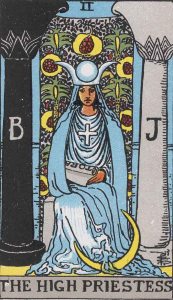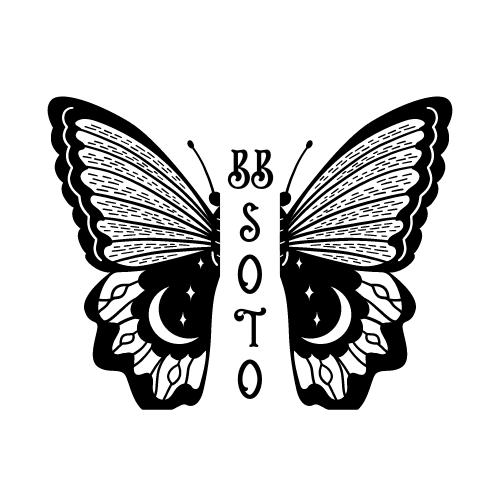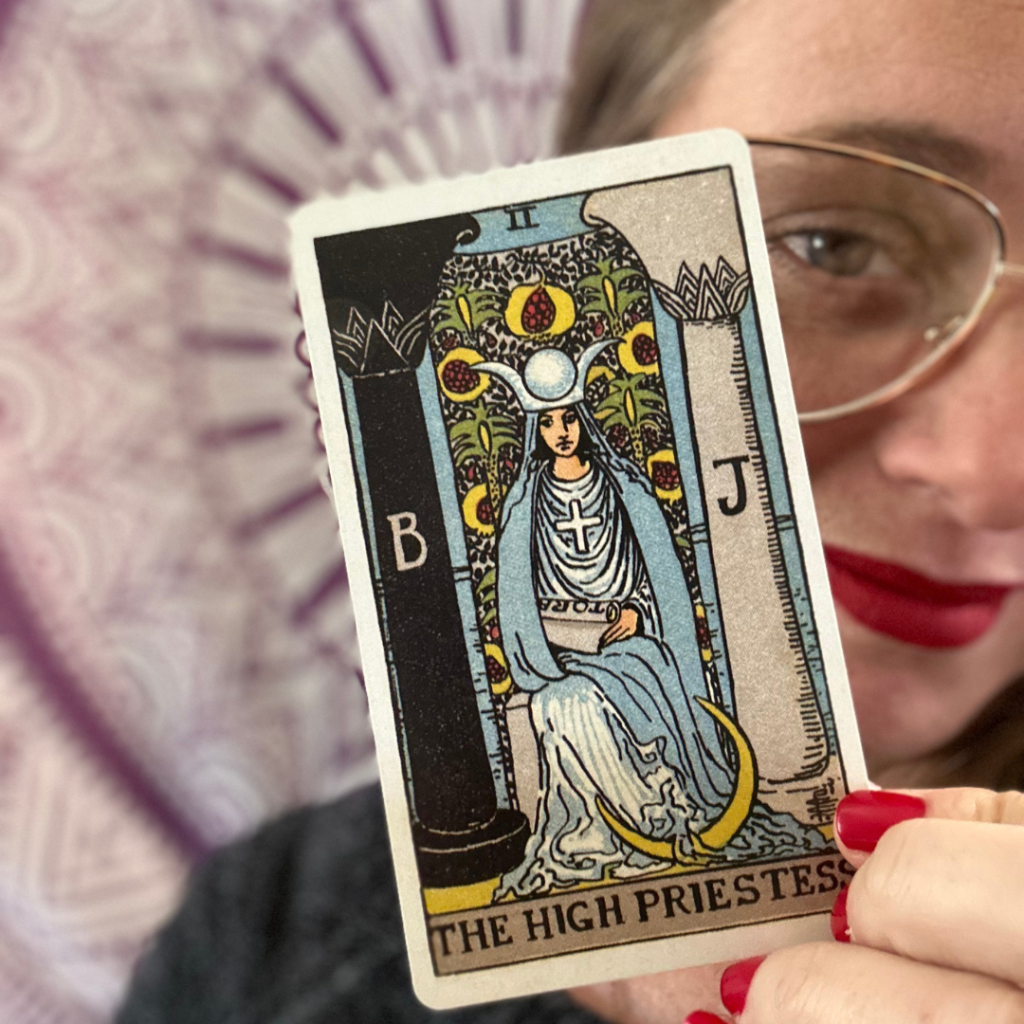She has been called occult Science on the threshold of the Sanctuary of Isis, but she is really the Secret Church, the House which is of God and man.
—A.E. Waite, The Pictorial Key to the Tarot, 1909

She’s one of the most enigmatic personages in the tarot. And rightly so as she is the personification of the wisdom in the veiled mysteries of life. Or is she?
Some claim her to be Pope Joan—a mythical medieval woman who rose to the ranks of pope by pretending to be a man and was only discovered once she gave birth. Because this card replaced what was La Papessa in the Visconti Tarrocchi deck—the most complete historical example still in existence believed to be the inspiration for what later became the Tarot—she still carries this association. The Visconti family who commissioned the deck were said to be descendants from a live woman who belonged to a religious sect that tried to make it possible for women popes. Their ancestor was burned for this, and it’s believed that is why they included La Popessa in their deck. It should be noted, their deck pre-dates the esoteric uses for the cards. Theirs was a deck intended to use in playing a game.
And Arthur Waite is clear in his Pictorial Key to the Tarot, he and Pamela Smith did not intend their High Priestess to represent Pope Joan or the Pope’s Wife. She is the embodiment of the Shekinah, one of Waite’s many written references to her being divine holy wisdom, the key to the secrets of the Universal Mysteries.
Aside from the cross on her garments, there’s not evidence to suggest the Pope Joan reference is even thinly intended. And when the context of that Christian symbol is taken with all the goddess references, it’s clear Waite & Smith are referencing the virgin mother Mary and the Christian Mysteries she holds as the mother to Christ, divinity on earth.
To make her Pope Joan—to limit her to representing a single mythical character within a single religion’s history—it’s far too narrow a space for the High Priestess. She may be, perhaps, one of the most universal archetypal characters in the deck. Not as Pope Joan, but as the High Priestess. As the embodiment of divine wisdom, that secret knowledge we’re all born with but not everyone can easily tap into. She’s the gateway to the collective unconscious.
To watch the video giving further explanation and comparisons of how she’s depicted in over ten different decks, click here.
And almost every culture I’ve studied has a goddess or deity or myth about an historical woman who was that gateway.
They’re often associated with the moon, resurrection, and motherhood to all by way of a child who then becomes a god.
When I started digging into the goddess lore embedded not only in the High Priestess herself, but in the symbols on her clothes, the veil behind her, the columns, and so on, it blew my mind. The depths of connections going further and further back, a goddess by any other name is just a goddess of divine wisdom. From ancient Sumeria to Egypt to Greece, Rome, Israel, and Medieval Christianity. She is there. Different names. Different rites and rituals. But the essence is always the same.
Divine wisdom and our way to connect is through the life giving force and yin energy of women.
The phases of the moon indicate the cycles of life—maid, mother, crone. And we have a different level of knowing, that deep, down to our bones kind of knowing, at each stage. She, though. She is all at once, ever knowing everything there is to know.
Water collects the collective and personal unconscious. She is one with the water at the hem of her blue robes which look an awful lot like Mary the Queen of Heaven’s robes. She holds a scroll as Mary is often shown holding a book. The scroll says TORA—the Word of God as revealed to Moses, and as written in the first five books of the Hebrew Scriptures. Her crown is Isis’ “horned diadem,” not the triple moon as would become associated with her in many decks derived from Smith’s original depiction here. She is the queen of the moon, the crescent present at her feet.
Her hair being veiled is another tie back to Inanna (Sumer), Isis (Egypt), Athene (Greece) who have all been associated in varying ways with a phrase, “I am all that has been and is and shall be; and no mortal has ever lifted my mantle.” And therefore a veiled goddess is historically another way of suggesting she is the knower of the mysteries.
Which brings us to all of these lovely ladies tie back to Sophia, the goddess of wisdom, who is said to be the same person under all these other names. She’s also the black goddess, the white goddess, the veiled goddess.
Pomegranate seeds are a symbol of fertility both on earth and out of the underworld—the fertility of life anew each spring and in the resurrection of our soul as we travel through the Fool’s Journey. Persephone ate pomegranate seeds and was forever bound to spend part of the year in the underworld but could rise during spring to visit her mother Demeter. With each year and Persephone’s resurrection, spring blooms. The palms with the pomegranates on the veil behind her are another symbol of resurrection from Egyptians to Roman times. The Egyptians would lay palms on the mummies, and the people laid palms at Jesus’ feet as he entered Jerusalem where he later died and was resurrected.
Ultimately, she is the archetype found in every culture of a person representing divine knowing. Here, Pamela Smith packed as much information as she could into this scene to let us know, she meant this person to represent that universality, not to be understood by only one faith, but by all. Making it all the more genius, as that connection to the collective unconscious the High Priestess has, she’s the knower of the universality that is the human condition regardless of cultural upbringing and religious beliefs. We are all born, created from almost nothing to something. And we all die. What will happen after that? Only she knows.
Next up, we’ll explore the theme of duality as seen in the columns. Then, goddess symbolism—Pomegranates, moon, triple moon, veil, scroll/book—and their mythical sources (gulp! I’ve already been working on this and it’s mind-blowingly all-encompassing). Then, we’ll deep dive (pun intended) into the symbolic meanings of water in the tarot.
In the meantime, if you’re interested in learning more and having early access to tarot symbolism research, check me out on Patreon. If you’d like to get a reading with me, check out my Tarot page too 🙂
References:
Butler, Hazel. n.d. “The Cult of Isis and Early Christianity.” Hohonu Volumes 10: 72–77. Accessed January 30, 2024. https://hilo.hawaii.edu/campuscenter/hohonu/volumes/documents/Vol05x19TheCultofIsis.pdf.
Dimo, Vasilev. “Palm Tree in Ancient Cultures.” My Myth Stories, November 24, 2019. https://mymythstories.com/palm-symbolism/.
Ferguson, George. Signs & symbols in Christian art. London: Oxford University Press, 1989.
“First Council of Nicaea – New World Encyclopedia.” n.d. Www.newworldencyclopedia.org. https://www.newworldencyclopedia.org/entry/First_Council_of_Nicaea.
Hundley, Jessica, and Penny Slinger. Tarot. Köln: TASCHEN, 2021.
Jack, Father Rob. “Bride in Song of Songs as a Type of Mary.” Bride in Song of Songs as a Type of Mary : University of Dayton, Ohio, January 17, 2024. https://udayton.edu/imri/mary/b/bride-in-song-of-songs-as-a-type-of-mary.php.
Kaplan, Stuart R., Mary Katherine Greer, Elizabeth Foley O’Connor, and Melinda Boyd Parsons. Pamela Colman Smith: The untold story. Stamford , CT: U.S. Games Systems, Inc., 2018.
Karoglou, Kiki. 2024. “Mystery Cults in the Greek and Roman World | Essay | the Metropolitan Museum of Art | Heilbrunn Timeline of Art History.” The Met’s Heilbrunn Timeline of Art History. 2024. https://www.metmuseum.org/toah/hd/myst/hd_myst.htm.
Matyszak, Philip. The gods et goddesses of greece et rome: A guide to the classical pantheon. London ; New York: Thames et Hudson, 2022.
Mourad, Suleiman A. “The Origin of the Palm Tree Story Concerning Mary And …” Smith College, 2002. https://sophia.smith.edu/~smourad/SA Mourad–From Hellenism to Christianity & Islam Origin of Palm Tree in Quran.pdf.
Pollack, Rachel. Seventy-eight degrees of wisdom: A tarot journey to self-awareness (a new edition of the tarot classic). 3rd ed. Newburyport, MA: Weiser Books, 2019.
Rasnic, Juliana. “Isis and Nut : Ancient Egyptian Art.” Symbolism in Art, 2001. https://www.people.vcu.edu/~djbromle/art-symbolism/student-projects-2001/isis-rasnic.html.
Rosenberg, Donna. World mythology: An anthology of the great myths and epics. 2nd ed. New York, NY: McGraw-Hill, 1994.
The Department of Medieval Art and The Cloisters. 2001. “The Cult of the Virgin Mary in the Middle Ages.” Metropolitan Museum of Art. October 2001. https://www.metmuseum.org/toah/hd/virg/hd_virg.htm.


Leave a comment